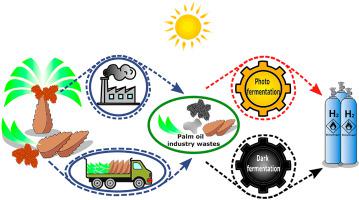Environmental Pollution ( IF 8.9 ) Pub Date : 2021-09-10 , DOI: 10.1016/j.envpol.2021.118160 Ee Shen Ong 1 , Alija Haydar Rabbani 1 , Mahmoud M Habashy 1 , Omar M Abdeldayem 1 , Eslam G Al-Sakkari 2 , Eldon R Rene 1

|
By the year 2050, it is estimated that the demand for palm oil is expected to reach an enormous amount of 240 Mt. With a huge demand in the future for palm oil, it is expected that oil palm by-products will rise with the increasing demand. This represents a golden opportunity for sustainable biohydrogen production using oil palm biomass and palm oil mill effluent (POME) as the renewable feedstock. Among the different biological methods for biohydrogen production, dark fermentation and photo-fermentation have been widely studied for their potential to produce biohydrogen by using various waste materials as feedstock, including POME and oil palm biomass. However, the complex structure of oil palm biomass and POME, such as the lignocellulosic composition, limits fermentable substrate available for conversion to biohydrogen. Therefore, proper pre-treatment and suitable process conditions are crucial for effective biohydrogen generation from these feedstocks. In this review, the characteristics of palm oil industrial waste, the process used for biohydrogen production using palm oil industrial waste, their pros and cons, and the influence of various factors have been discussed, as well as a comparison between studies in terms of types of reactors, pre-treatment strategies, the microbial culture used, and optimum operating condition have been presented. Through biological production, hydrogen production rates up to 52 L-H2/L-medium/h and 6 L-H2/L-medium/h for solid and liquid palm oil industrial waste, respectively, can be achieved. In short, the continuous supply of palm oil production by-product and relatively, the low cost of the biological method for hydrogen production indicates the potential source of renewable energy.
中文翻译:

棕榈油工业废料作为一种有前途的生物制氢原料:综合综述
到 2050 年,预计棕榈油需求量将达到 240 Mt。随着未来对棕榈油的巨大需求,预计油棕副产品将随着需求的增加而上升。要求。这代表了使用油棕生物质和棕榈油厂废水 (POME) 作为可再生原料进行可持续生物氢生产的黄金机会。在生物制氢的不同生物方法中,暗发酵和光发酵因其利用各种废料作为原料(包括 POME 和油棕生物质)生产生物氢的潜力而被广泛研究。然而,油棕生物质和 POME 的复杂结构,例如木质纤维素成分,限制了可用于转化为生物氢的可发酵底物。所以,适当的预处理和合适的工艺条件对于从这些原料中有效产生生物氢至关重要。在这篇综述中,讨论了棕榈油工业废料的特性、利用棕榈油工业废料生产生物制氢的工艺、它们的利弊以及各种因素的影响,并在类型方面进行了研究比较。已经介绍了反应器、预处理策略、使用的微生物培养物和最佳操作条件。通过生物生产,制氢率高达 52 LH 讨论了它们的优缺点和各种因素的影响,并在反应器类型、预处理策略、使用的微生物培养和最佳操作条件方面进行了研究之间的比较。通过生物生产,制氢率高达 52 LH 讨论了它们的优缺点和各种因素的影响,并在反应器类型、预处理策略、使用的微生物培养和最佳操作条件方面进行了研究之间的比较。通过生物生产,制氢率高达 52 LH对于固体和液体棕榈油工业废物,可分别达到2 /L-medium/h 和 6 LH 2 /L-medium/h。简而言之,棕榈油生产副产品的持续供应和相对较低的生物制氢方法成本表明可再生能源的潜在来源。



























 京公网安备 11010802027423号
京公网安备 11010802027423号